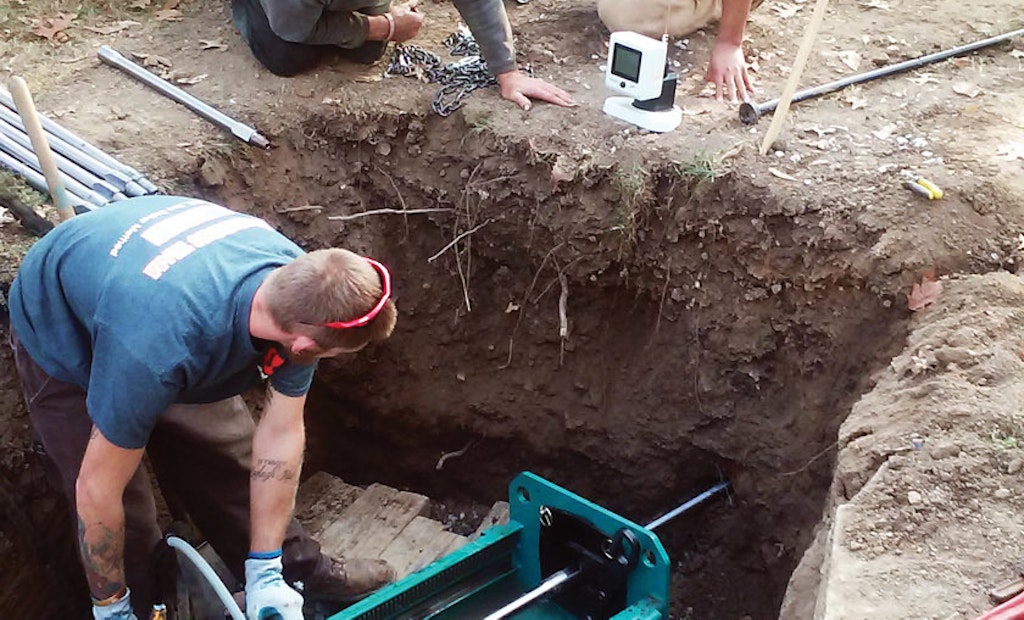
Andrew Jackson of Underground Connections runs the RODDIE Pit Shot directional drilling machine while foreman Clark Kinney (center) and Jeremiah Kinney help from outside the pit.
For years, Tom Carlisle was frustrated because he couldn’t serve a large untapped market for boring new waterlines and sewer lines, which he envisioned as a great bolt-on business for his trenchless pipeline rehabilitation company, Underground Connections, based in Wooster, Ohio. The main obstacle: the high cost of horizontal directional drilling equipment.
But he’s not frustrated anymore, thanks to the Pit Shot, a compact directional drilling machine made by RODDIE. “I saw it at the Water & Wastewater Equipment, Treatment & Transport (WWETT) Show two years ago,” he recalls. “I immediately thought it would be a game-changer. And it has been.”
The Pit Shot has led to a 25 to 30 percent increase in revenue since he invested $55,000 in it two years ago. “I have a dedicated crew of two guys for that machine, and it goes out almost every day,” says Carlisle, whose company serves the metro Cleveland, Columbus and Cincinnati areas. “It also has increased our capacity to help out customers with certain things that we couldn’t do before we invested in this technology.”
The pit launch machine’s compact size and power were big selling points for Carlisle, who established his pipe bursting and lining company in 2007 and now employs seven people. The unit measures 4 feet 4 inches long, 20 inches wide, and 2 feet tall; it weighs 595 pounds. It generates 13,000 pounds of push/pull force and 720 ft-lb of rotational torque, with a rotational speed up to 150 rpm. Its drilling range is 400 feet, and it’s designed to drill holes 4 to 6 inches in diameter. Safety features include a clutch that stops the rods from spinning if the drill head binds up during drilling. A waterline keeps the drill head cool and lubricates the ground for easier drilling.
“It fits in an excavation pit that’s only 4 feet long and 2 feet wide,” he says. “The depth depends on the line we’re installing. We use either a tripod or a mini-excavator — or even a wooden ramp — to lower it into the pit. Then you commence drilling.”
Crews use a locator to track the hydraulically driven drill head, which includes a built-in sonde. One crew member steers the drill head and adds 2-foot-long sections of rods while the other handles the locator. “It’s a very accurate sonde,” he notes. “It tracks things like depth, pitch and even the temperature of the drill head. That’s important because you don’t want it to overheat: It throws off the locator and can melt things.”
After the new bore is drilled, the drill head gets replaced with a device called a back reamer. “That cuts a larger hole (as it’s pulled back to the starting point) and pulls a high-density polyethylene pipe through at the same time. At that point, the process is very much like pipe bursting.”
The machine is capable of drilling about 150 feet per hour, depending on soil conditions and other factors. “That’s real fast,” he says. “It was hard to believe when we first bought the machine.” The longest drilling job Underground Connection tackled was 250 feet.
The company primarily uses the machine to drill new waterlines and sewer lines to homes that are converting either from septic systems to sewer service or from well water to municipal water. “That’s a big part of the market we were missing before,” he says. “Thousands of homes are undergoing conversions.”
But the Pit Shot is also used to drill new pipelines for homes where the original waterlines or sewer lines are so badly damaged they can’t be rehabbed, he points out. “Sometimes those lines have bellies or offsets in them, so we have to drill a new line right next to it on grade,” he says.
The toughest job Carlisle has performed so far with the Pit Shot? Drilling a 150-foot-long bore underneath a warehouse at a car-manufacturing plant in Cleveland to replace a crushed sanitary sewer line. “We do the kinds of jobs that nobody else wants to do, because we can,” he says.
Customers “absolutely love” the machine, he says. That leads to repeat business and word-of-mouth referrals for his company, which he estimates will generate nearly $2 million in gross revenue in 2017. His goal for 2018: $3 million in sales. Plumbers that hire Underground Connections as a subcontractor are also impressed with the Pit Shot, he adds.
Moreover, as time goes on, Carlisle continues to find other uses for the machine, including drilling bores for electric lines, irrigation systems, water mains and gas lines. “Pretty much anything you want to drill underground, we can do it,” he says.





